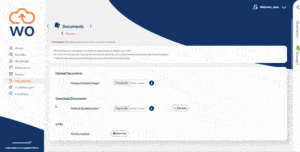1. What are your top tips given the current situation for companies to seamlessly transition from the on-boarding process to induction (which now can’t be face to face)
It can be tricky and will take a bit of adaptation, I would suggest that the best approach would be to use the tools that are available to simulate the process that you usually follow. If a team lunch is a normal first day process why not have a virtual lunch instead? Get heads of department onto Skype/Zoom/Hangouts to discuss their teas and how they fit into the company overall.
Try as much as possible to treat the first day and first week as you would normally, share your presentations with people, educate them on how to effectively work remotely, have virtual tea breaks with other team members, bring as much of the social aspect into the process as you can so that they really feel like a part of the team. Integration is such a key part at this stage so don’t let it drop off.
2. Who should manage the onboarding process and check it’s happening? Managers/HR/other?
This question is the root of why onboarding can fall through the gaps. I think everyone connected to the new hire has some responsibility in the process but someone who knows how everything should be done has to take control of it to make sure it is all done. I typically see that working best with someone from the Recruitment or HR team, although if you have significant volumes it could be worth dedicating a specific resource to this.
It is important to involve managers in the process and give them visibility but with the best will in the world their focus and time might not be best placed chasing for desks, equipment or uniforms. I think the best use of managers is as a resource to facilitate the integration into the team, assigning a good buddy, organising team activities, shadowing sessions and things like that.
3. When is best to introduce to the team? Day one currently is full blown induction so no team engagement – should this be done on day one?
Personally I think it is a key thing to get in on day one or before. Exactly how to approach this will depend on the role and your organisation though. I have seen graduate recruitment processes where candidates have lunch with the team, a good assessment of how someone might fit in, we have even had people come along to social events when they have been happening ahead of someone’s start date.
I’m sure there are some breaks during the day one induction sessions (if they all have to be on day one) where some of the team can be involved. Most people connect well with a chat over a cup of tea or coffee (even if it is done virtually), and sharing stories over food is a practice that predates all of our office environments so that works well too.
4. What would be the best situation for current employees to do to make the new employee feel more welcoming into the business?
There are a few ways to approach this. I personally like the team lunch with some of the people a new hire will be working closely with and some of the wider team too. Another nice thing I saw in one of our partner’s offices was a welcome balloon which encouraged people from around the business to come and introduce themselves to the new starter. Don’t make it feel too much like organised fun, just try and get the people together that will allow relationships to start to build and flourish, keep in mind that the strongest relationships in a business aren’t always the most obvious fits either.
5. Gathered from 90 day feedback forms – Hiring Manager will listen to new employee, however not action any concerns due to other priorities
This is where some ownership is important from the person who controls the entire process. I often see people map out an onboarding process that includes a check in with the new hire after, 7, 30 and 90 days for example but not a step to check in with the manager. It is important that everyone can communicate concerns or feedback on the process to all involved parties so that actions can be decided. The other important part here would be to encourage managers to communicate things back to the new hire too, let them know their concerns have been heard and that some assessment on how to correct things has taken place even if it won’t happen immediately.
6. Would you recommend getting the boring bits done prior to starting? If so, how do you prevent this giving a poor cultural impression of the organisation?
Yes, 100%. With one caveat, make it easy to do and find ways to deliver interesting and informative stuff too. If you think getting people to fill in a HMRC form gives a poor cultural impression then that impression will be much worse if a large chunk of day one is just form filling. Give them the tools to be able to do it in their own time, at their own pace.
7. Post 3 months – potential gap from there until the end of year 1. After 3 months/probation people can sometimes get lost – how do you keep employees engaged?
I think the solution to this really comes from the groundwork you lay at the beginning of the process. The point of good onboarding isn’t just to get people through probation, it is to deliver a productive employee that stays for years to come. That is where the real return on a recruitment investment comes from. If you deliver a engaging process before someone starts and through their first few months of work then it becomes much easier to keep them engaged long term as that is the relationship that has been built. Some other things that can help with this though are to work with the employee to build out objectives (preferably SMART ones) that don’t just relate to the standard KPIs of their role. It shouldn’t detract from someone doing their job but small projects that contribute to the overall improvement of the business really give people a sense of involvement in the overall goals.
8. At my NHS Trust we ended up building a Line Manager Portal to “help” the managers to support the candidate. The OB system was working well, but it highlighted line manager issues
I can see how that could happen quite easily. For an onboarding process to truly work well it needs all of the stakeholders to have some involvement and ownership of the parts that relate to them. Line managers aren’t always great at this stuff so any support that can be provided will improve the process overall and the results that you get. If you can get it all in one place too rather than in separate systems then life becomes easier for everyone.
9. Keen to know of any effective apps which have proved stronger engagement for onboarding.
My slightly biased answer here is Webonboarding although I think it does really depend on the particular area that is causing the engagement to drop. I would caution against getting something that seems to fix a single part though as you may just end up pushing issues down the line.
10. How can we get hiring managers engaged from offer to day one of joining
You have to help hiring managers buy in to the process and the best way of doing that is to help educate them on the difference it can make. You can use tools to help remind people to take actions but unless you let them know how that action will help them achieve more in their role it will always seem like a chore that can be put off. WIIFM is probably how they think about a list of actions that you give them to do so let them know what they gain from doing them and then make them easy to carry out. Also try to avoid giving them tasks that don’t bring them a net positive result.
11. Onboarding employees at different levels in different ways
This is important, onboarding processes should never be a one size fits all. I think the backbone of your process can be the same across the business but you might need to vary things for different roles. Sometimes that can be very practical things such as enhanced screening checks, sometimes a director may need a longe initial meeting with the CEO.
Try to have these variables documented and, where possible, use something that can template the processes for each role making it easy to pick the right one. Don’t fal into the trap here of giving one level the Rolls Royce of onboarding at the expense of others though, show all new hires that they are valuable to the business with the best experience possible.
12. Different channels, mix up the boring emails
This is a good approach. Use different methods of communication, different types of media, make emails more than just a basic copy and paste template, show the company culture in all communications.
13. Improved communications between HR/Recruitment after the first day business induction and improving the hiring managers engagement with on-boarding
See above
14. Onboarding: less overwhelming, more consistency between departments after induction is complete and more fun
The key is to have a plan that the whole business can buy into. Again you need to sell people on the results they will get by doing this but if you can get teams, especially ones who struggle with this or have poor retention stats, involved in the creation they will take more ownership on getting it done. Remember that what a “fun” process is can be very subjective. I know that across our business with around 100 employees the interpretation of that would be very different because of the wide variety of personalities and cultures that we employ.
15. Automatic notifications – making them relevant to different job roles
See above – tailoring the process
16. From this presentation: The phasing of the onboarding process – we currently give everyone access to everything.
It is important to keep the new hire engaged an avoiding information overload is a key part of that. You might also run into issues around sensitive information that you don’t want to release. Many companies have an internal document around information and data security policies that they would not want to release until at least things like contracts and any Non Disclosure Agreements had been returned.
17. Staggered onboarding
See above re: phasing
18. Time to hire
This can be a problem in a lot of industries, both from a short turnaround to the longer notice periods you sometimes see. In some instances the delays are unavoidable, screening and DBS checks can take time for example but one of the key things here is to make it quick and easy for the new hire to get into the process.
If you want to get people through the door quickly you need something that allows you to create and send things like contracts and offer letters in minutes and then have a system that guides the onboardee through the rest of the essential stuff easily. Make it so that they can do it on the go, whether that is in a lunch break at their current role or, like a recent hire here, whilst out doing the weekly shop. Don’t have it rely on the person being at home or near a printer asd you are onl putting more delays into the process. We have a customer who it used to take about 10 days for a new starter to complete everything, now they can send the information on Friday do it all over the weekend and have someone ready to start on a Monday with everything completed.
The other end of the spectrum is the long lead times and keeping people engaged and this needs a slightly different approach so it is important that your process has considerations for this too. Staging the release of content, keeping in contact regularly, inviting people to social functions and keeping the hiring manager engaged are all important here.
19. Anyone using an app?
See question 9 as above. Webonboarding have fully mobile enabled onboarding for new hires, meaning that it can be accessed on the go, key documents can be completed via digital signing and form filling. It also allows a smooth transition from offer to acceptance, giving the best possible onboarding experience for your new hire along the way and introducing them to their new role.
20. Regular and timed communications is something I have been looking to implement
See above
21. Sometimes what I think is really a challenge is the team/manager to effectively have the time to onboard properly the person. Any tips?
See above re: buy in and engagement from managers and teams




